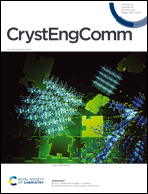Two highly stable inorganic–organic hybrid 3D frameworks based on Cu–Ln incorporated polyoxometalates for selective dye removal and proton conduction†
Abstract
Two novel inorganic–organic hybrid 3D TM–Ln incorporated POM-based frameworks, H2[Cu2OL3(H2O)2][Ce(L)(H2O)3(PW11O39)]·17H2O (1) and H4[CuL3]2[Ln(H2O)3(PW11O39)]2·28H2O (2) (L = 4,4′-bipyridine), were hydrothermally synthesized at different temperatures. Structural analysis reveals that both compounds are constructed from [Ln(PW11O39)]4− polyoxoanions and different copper complexes. Interestingly, in compound 1, 2D copper complex layers and 1D chain [Ln(PW11O39)]4− polyoxoanions interconnect to form a 3D framework. In contrast, in compound 2, 1D copper complex chains join the 2D [Ln(PW11O39)]4− layers to give rise to a 3D framework. Both compounds exhibit excellent chemical stability. Furthermore, the dye adsorption and proton conduction properties of both compounds were also investigated. The conductivities of 1 and 2 are 3.175 × 10−4 S cm−1 and 1.750 × 10−4 S cm−1 at 85 °C and 98% RH, respectively. Dye adsorption studies indicate that they can selectively adsorb cationic dyes MB, CV and BR over anionic dyes MO, AO and large cationic RhB.

- This article is part of the themed collection: Coordination Networks


 Please wait while we load your content...
Please wait while we load your content...